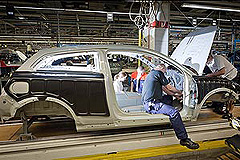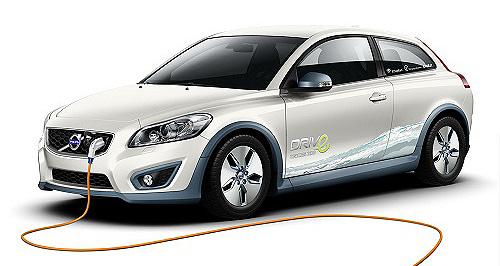Make / Model Search
Future models - Volvo - C30Volvo Australia warms to C30 ElectricGreen Swede: Volvo's C30 Electric is now in production for European markets, but could also surface closer to home. C30 Electric production commences in Sweden and Volvo Australia confirms interest13 Jun 2011 VOLVO’S first plug-in car could be sold in Australia after all, if the Scandinavian brand can establish a local business case for the ground-breaking C30 Electric hatchback, which entered production in Sweden last week. When it debuted at the Paris motor show last October, Volvo Cars Australia (VCA) said the company’s inaugural EV was not a priority for local release because of the lack of Australian government incentives and charging infrastructure compared with other countries. At the time, VCA confirmed none of the initial batch of 250 all-electric C30s to be built by the end of 2012 - including the first 50 for government and company fleet testing in Europe, China and the United States from early this year – had been earmarked for Australia. Now, Volvo’s local arm has confirmed its interest in the C30 plug-in, which will be delivered to lease customers in Sweden, Belgium, the Netherlands and Norway from August. “We’ve seen the initial information from Volvo Cars Corporation and have expressed interest in the car,” said Volvo Cars Australia public affairs manager Jaedene Hudson. “The next stage will be to put together a business case to see if the car will be viable in our market.” Previously, VCA had said it would hold back the release of fully electric models here until Australia was ready for it, in the same way that it has delayed introducing its range of E85 flex-fuel models until the widespread availability of ethanol pumps in Australia. Currently, the 1.6-litre diesel-powered C30 DRIVe, which consumes a hybrid-like 3.9L/100km and emits 104g/km of CO2 to be one of the nation’s most efficient models, flies the green flag for Sweden’s largest motor manufacturer in Australia. Late last week Mitsubishi announced it would commence public sales of its pioneering i-MiEV electric car in Australia from mid-August. The i-MiEV was the first mass-production EV to hit Australia last year, when limited supplies were released to selected lease customers, who will end up paying more over their three-year term than the public purchase price of about $50,000.  Nissan’s all-electric Leaf hatchback and GM Holden’s similarly sized plug-in hybrid Volt hatch have also been confirmed for Australian release next year, and the three-door C30 Electric’s zero-emissions drivetrain and trademark Volvo safety could be a compelling point of difference for some. Nissan’s all-electric Leaf hatchback and GM Holden’s similarly sized plug-in hybrid Volt hatch have also been confirmed for Australian release next year, and the three-door C30 Electric’s zero-emissions drivetrain and trademark Volvo safety could be a compelling point of difference for some.The C30 Electric can be recharged from a regular household power socket in seven hours and has a claimed 150km driving range. It is said to complete the 0-100km/h dash in a respectable 10.9 seconds on its way to a top speed of 130km/h. The first Scando-EV is built at Volvo’s Ghent assembly line before being sent to Gothenburg for installation of the motor, batteries and electronics. Batteries are fitted in the space usually occupied by the fuel tank and in a special compartment in the car’s centre tunnel, leaving luggage capacity unchanged. Volvo claims the car is as safe as the standard C30, which attracts a maximum five-star Euro NCAP rating. The C30 Electric was part of a novel publicity exercise by Volvo in Sweden called One Tonne Life, in which the Lindell family - dad Nils, mum Alicja and teenagers Hannah (16) and Jonathan (13) - aimed to limit each of its members to one tonne of CO2 emissions per year. As part of the study, which was officially closed today by Sweden's environmental affairs minister Andreas Carlgren, the Lindells swapped their normal 1970s villa and decade-old cars for a brand-new, climate-smart wooden house and a battery-powered C30 for six months. Volvo said most reductions were made in the areas of transport and electricity consumption, with emissions from transport dropping by more than 90 per cent, thanks mostly to the fact the C30 was recharged using electricity from hydropower. Overall, the Lindells are said to have reduced their carbon footprint by almost 80 per cent, from 7.3 tonnes of CO2 annually before the four of them moved into the energy-efficient house outside Stockholm in January to just 1.5 tonnes. One tonne of CO2 per person per year is said to roughly correspond with the level that might be necessary to avoid serious climate change. But the Lindell family’s 80 per cent drop from their initial CO2 output – and each member’s eventual total of about 562kg – is claimed to demonstrate that the Swedish government's climate target of a 40 per cent reduction in CO2 emissions by 2020 is already within the reach of the average household using latest technologies. The One Tonne house produced its own power and was provided with supplementary renewable electricity from hydro-power, but the Lindells also made big CO2 reductions in the kitchen, by not wasting food, choosing different meats and eating more vegetables. Towards the end of the six-month trial period the Lindells ate only vegetarian dishes and dairy produce was replaced with soya and oats-based alternatives, but in the last week they avoided most of their usual food, stopped shopping, watched no TV and closed off one room and its amenities to further reduce their emissions. However, with each person burdened by an additional 900kg CO2 ‘rucksack’ - accounting for the emissions produced in the construction of the house and its solar panels and furniture, and the manufacture of the family’s clothes and C30 Electric – the Lindells still fell short of the one-tonne target. “On our way down to 2.5 tonnes we didn't have to make any major compromises in our everyday lifestyles,” said Alicja Lindell. “After that, however, things got tougher. Living at the 1.5-tonne level was an extreme experience for us. “But with a ‘rucksack’ of 900kg, it still isn't possible to get all the way down to one tonne.”  Read moreAll future modelsMotor industry news |
Click to shareVolvo modelsResearch Volvo All future modelsMotor industry news |



 Alfa Romeo
Alfa Romeo Abarth
Abarth Audi
Audi Aston Martin
Aston Martin BMW
BMW Bentley
Bentley Ferrari
Ferrari Chevrolet
Chevrolet Ford
Ford Fiat
Fiat GWM
GWM Foton
Foton Hyundai
Hyundai Honda
Honda Jaguar
Jaguar Isuzu
Isuzu Kia
Kia Jeep
Jeep Land Rover
Land Rover Lamborghini
Lamborghini Maserati
Maserati Lexus
Lexus McLaren
McLaren Mazda
Mazda Mercedes-Benz
Mercedes-Benz Mitsubishi
Mitsubishi Mini
Mini Peugeot
Peugeot Nissan
Nissan Ram
Ram Porsche
Porsche Rolls-Royce
Rolls-Royce Smart
Smart Skoda
Skoda Suzuki
Suzuki Subaru
Subaru Toyota
Toyota Tesla
Tesla Volvo
Volvo Zeekr
Zeekr







Facebook Twitter Instagram